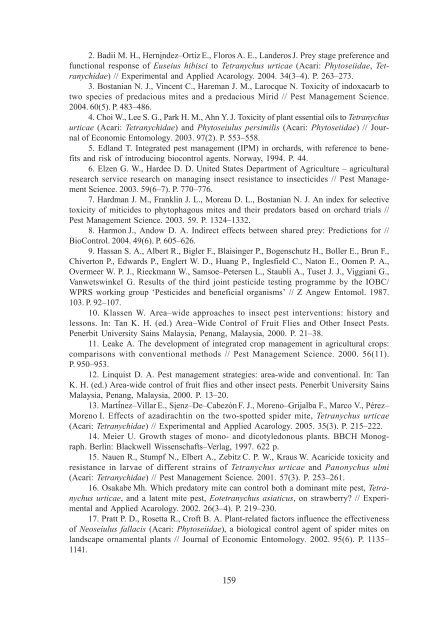You also want an ePaper? Increase the reach of your titles
YUMPU automatically turns print PDFs into web optimized ePapers that Google loves.
2. Badii M. H., Hernández–Ortiz E., Floros A. E., Landeros J. Prey stage preference and<br />
functional response of Euseius hibisci to Tetranychus urticae (Acari: Phytoseiidae, Tetranychidae)<br />
// Experimental and Applied Acarology. 2004. 34(3–4). P. 263–273.<br />
3. Bostanian N. J., Vincent C., Hareman J. M., Larocque N. Toxicity of indoxacarb to<br />
two species of predacious mites and a predacious M<strong>ir</strong>id // Pest Management Science.<br />
2004. 60(5). P. 483–486.<br />
4. Choi W., Lee S. G., Park H. M., Ahn Y. J. Toxicity of plant essential oils to Tetranychus<br />
urticae (Acari: Tetranychidae) and Phytoseiulus persimilis (Acari: Phytoseiidae) // Journal<br />
of Economic Entomology. 2003. 97(2). P. 553–558.<br />
5. Edland T. Integrated pest management (IPM) in orchards, with reference to benefits<br />
and risk of introducing biocontrol agents. Norway, 1994. P. 44.<br />
6. Elzen G. W., Hardee D. D. United States Department of Agriculture – agricultural<br />
research service research on managing insect resistance to insecticides // Pest Management<br />
Science. 2003. 59(6–7). P. 770–776.<br />
7. Hardman J. M., Franklin J. L., Moreau D. L., Bostanian N. J. An index for selective<br />
toxicity of miticides to phytophagous mites and the<strong>ir</strong> predators based on orchard trials //<br />
Pest Management Science. 2003. 59. P. 1324–1332.<br />
8. Harmon J., Andow D. A. Ind<strong>ir</strong>ect effects between shared prey: Predictions for //<br />
BioControl. 2004. 49(6). P. 605–626.<br />
9. Hassan S. A., Albert R., Bigler F., Blaisinger P., Bogenschutz H., Boller E., Brun F.,<br />
Chiverton P., Edwards P., Englert W. D., Huang P., Inglesfield C., Naton E., Oomen P. A.,<br />
Overmeer W. P. J., Rieckmann W., Samsoe–Petersen L., Staubli A., Tuset J. J., Viggiani G.,<br />
Vanwetswinkel G. Results of the th<strong>ir</strong>d joint pesticide testing programme by the IOBC/<br />
WPRS working group ‘Pesticides and beneficial organisms’ // Z Angew Entomol. 1987.<br />
103. P. 92–107.<br />
10. Klassen W. Area–wide approaches to insect pest interventions: history and<br />
lessons. In: Tan K. H. (ed.) Area–Wide Control of Fruit Flies and Other Insect Pests.<br />
Penerbit University Sains Malaysia, Penang, Malaysia, 2000. P. 21–38.<br />
11. Leake A. The development of integrated crop management in agricultural crops:<br />
comparisons with conventional methods // Pest Management Science. 2000. 56(11).<br />
P. 950–953.<br />
12. Linquist D. A. Pest management strategies: area-wide and conventional. In: Tan<br />
K. H. (ed.) Area-wide control of fruit flies and other insect pests. Penerbit University Sains<br />
Malaysia, Penang, Malaysia, 2000. P. 13–20.<br />
13. Martînez–Villar E., Sáenz–De–Cabezón F. J., Moreno–Grijalba F., Marco V., Pérez–<br />
Moreno I. Effects of azad<strong>ir</strong>achtin on the two-spotted spider mite, Tetranychus urticae<br />
(Acari: Tetranychidae) // Experimental and Applied Acarology. 2005. 35(3). P. 215–222.<br />
14. Meier U. Growth stages of mono- and dicotyledonous plants. BBCH Monograph.<br />
Berlin: Blackwell Wissenschafts–Verlag, 1997. 622 p.<br />
15. Nauen R., Stumpf N., Elbert A., Zebitz C. P. W., Kraus W. Acaricide toxicity and<br />
resistance in larvae of different strains of Tetranychus urticae and Panonychus ulmi<br />
(Acari: Tetranychidae) // Pest Management Science. 2001. 57(3). P. <strong>25</strong>3–261.<br />
16. Osakabe Mh. Which predatory mite can control both a dominant mite pest, Tetranychus<br />
urticae, and a latent mite pest, Eotetranychus asiaticus, on strawberry // Experimental<br />
and Applied Acarology. 2002. 26(3–4). P. 219–230.<br />
17. Pratt P. D., Rosetta R., Croft B. A. Plant-related factors influence the effectiveness<br />
of Neoseiulus fallacis (Acari: Phytoseiidae), a biological control agent of spider mites on<br />
landscape ornamental plants // Journal of Economic Entomology. 2002. 95(6). P. 1135–<br />
1141.<br />
159

















